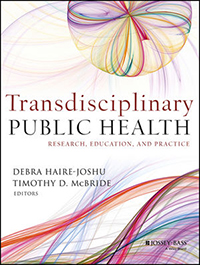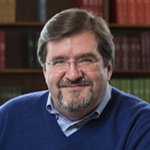Widespread societal problems — such as hunger, access to clean drinking water and, closer to home, obesity and health disparities — are nothing new. The need to address these complex and persistent problems is providing an opportunity for innovative training approaches in public health.

“For the lay person, ‘working together’ is a good way to describe ‘transdisciplinary,’” Haire-Joshu said. “It’s really about bringing together different perspectives in a room — people who speak very different languages — to solve a public health problem.”
Haire-Joshu and McBride began working on the book in 2009; at the same time, both professors were part of the team that built the master’s in public health program at the Brown School.
“‘Transdisciplinary’ is not a new idea,” said McBride, who served as the first associate dean of the MPH program. “Problems don’t exist in a vacuum; most federal research grants require a transdisciplinary approach now. So when we were building our program, we wanted to build it around this idea.

“The Brown School’s unique contribution is in that we asked ourselves, ‘If this is being required in research grants, then why are we not training master’s in public health students to be thinking this way from the beginning?’” McBride said.
Haire-Joshu, director of WUSTL’s Obesity Prevention and Policy Research Center, gives an example of how this approach can help address an issue such as obesity.
“Obesity is the result of multiple — as opposed to singular — causes,” she said. “Obesity can result from biological mechanisms that regulate metabolism, can be influenced by lifestyle behaviors, and impacted by policies, rules and regulations that influence the environment.
“All of these perspectives together need to have a voice in the solution,” Haire-Joshu said. “A basic scientist finds answers to obesity from the biologic or metabolic perspective. A behavioral scientist might explain obesity by understanding factors that influence decision-making around what or how an individual eats. A policy researcher answers questions from a cost or population perspective. Each has one piece of the solution in achieving the common goal of ‘How we do prevent obesity?’
“‘Transdisciplinary’ is a way of bringing disciplines together that speak very different languages to come up with a model that integrates all these perspectives,” she said.
That’s exactly what the book has set out to do, and Haire-Joshu and McBride, also both faculty scholars at the university’s Institute for Public Health, assembled a team of scholars from WUSTL and around the country that produced, as McBride puts it, “a tool kit for academics.” More than a dozen Brown School and university faculty members contributed to the book.
While the early chapters define the approach and lay out theories, the second half of the book provides practical applications and case studies, both domestic and global, in areas of:
- maternal-child obesity;
- violence and injury prevention and treatment among children and youth;
- systems used in addressing public health disparities;
- global hunger and undernutrition;
- safe drinking water in rural India; and
- indoor air pollution and respiratory health.
“The book literally takes you through how to apply these methods and why it might be beneficial to do so,” McBride said.
“The use of this important resource will promote transdisciplinary research and practice,” Lawlor said. “It’s exactly the kind of program we’re building at the Brown School — finding novel solutions that positively impact human health.”
To read more about Transdisciplinary Public Health, visit http://www.wiley.com/WileyCDA/WileyTitle/productCd-0470621990.html.